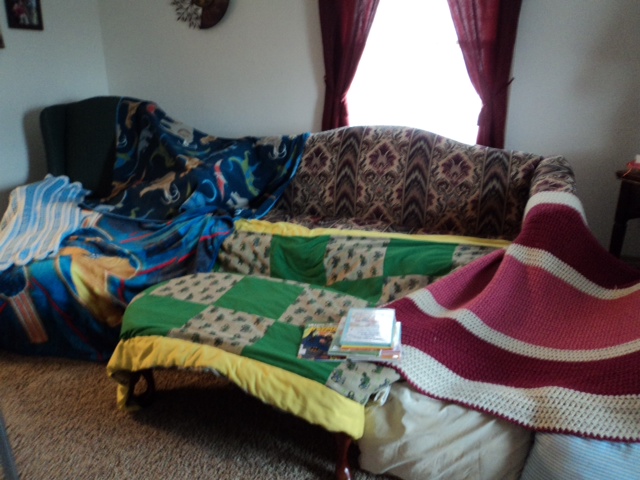Yup. This is how my living room looks on a regular basis. No, my decorating style is not “early refugee motif.” Those of you with creative kids will recognize this in a heartbeat. This is yet another installment in Adventures in Fort-building. My kids love make contraptions from junk and forts from blankets. Do I like the mess? No, but I love the creativity and innovation it shows.
My husband was listening to an audio book recently by Rabi Daniel Lapin. In the section I heard, Rabi Lapin was citing a fascinating study. The creativity test used by NASA to screen potential participants in the space program was administered to 5 year olds. 98% of the 5 year olds scored “Highly Creative.” The same test was given to 10 year olds. 30% of them scored “Highly Creative.” When adults were tested, only 2% scored “Highly Creative.” What happens between age 5 and adulthood that causes creativity to plummet? Rabi Lapin surmises that one reason for the decrease is level of connectivity. The life of most 5 year olds is about playing with others and interacting constantly with parents and other important people in their life. As they age, they spend more time in watching TV and playing video games – activities that diminish interaction with others. The standard school experience involves hours a day engaged in activities not requiring a lot of interaction and creativity. Rabi Lapin concludes that creativity is directly proportional to connectivity. The more you are connecting with others, the more creative you will be.
I would not deem his theory flawless, as I would say adults interact with people throughout their day as much as if not more than 5 year olds. Personally, I think how we are trained to approach life and its situations has more to with our level of creativity. But I definitely acknowledge the importance of connecting with others and would agree it is an essential key to success in life.
This makes me think about my experience with traditional education, both as a teacher and a parent of public school children. If I were to think back to my teaching days and add up the time spent in the classroom doing the tasks necessary to managing 20 students but not directly related to instruction, interactive connection, or creativity, and if I think about the hours I spend each week now transporting my kids to school (although those are some of my favorite connecting times), school fundraising efforts, school paperwork, day-to-day scheduling, I have to draw one honest conclusion: homeschool would have the potential to increase connectivity and creativity. There would be more time to connect with my children and for them to build connections with each other. There would be more time to be creative and pursue that important question, “What would happen if . . . “ We would have more time to shape how our children learn to approach life.
Perhaps we need to take a cue from our second son, take a good look at the “resources” around us, and venture to build something new for our family.

One of my sons with his creations made from the recycling bin.
Source:
Lapin, Rabi Daniel, Prosperity Power: Connect for Success, 2010

